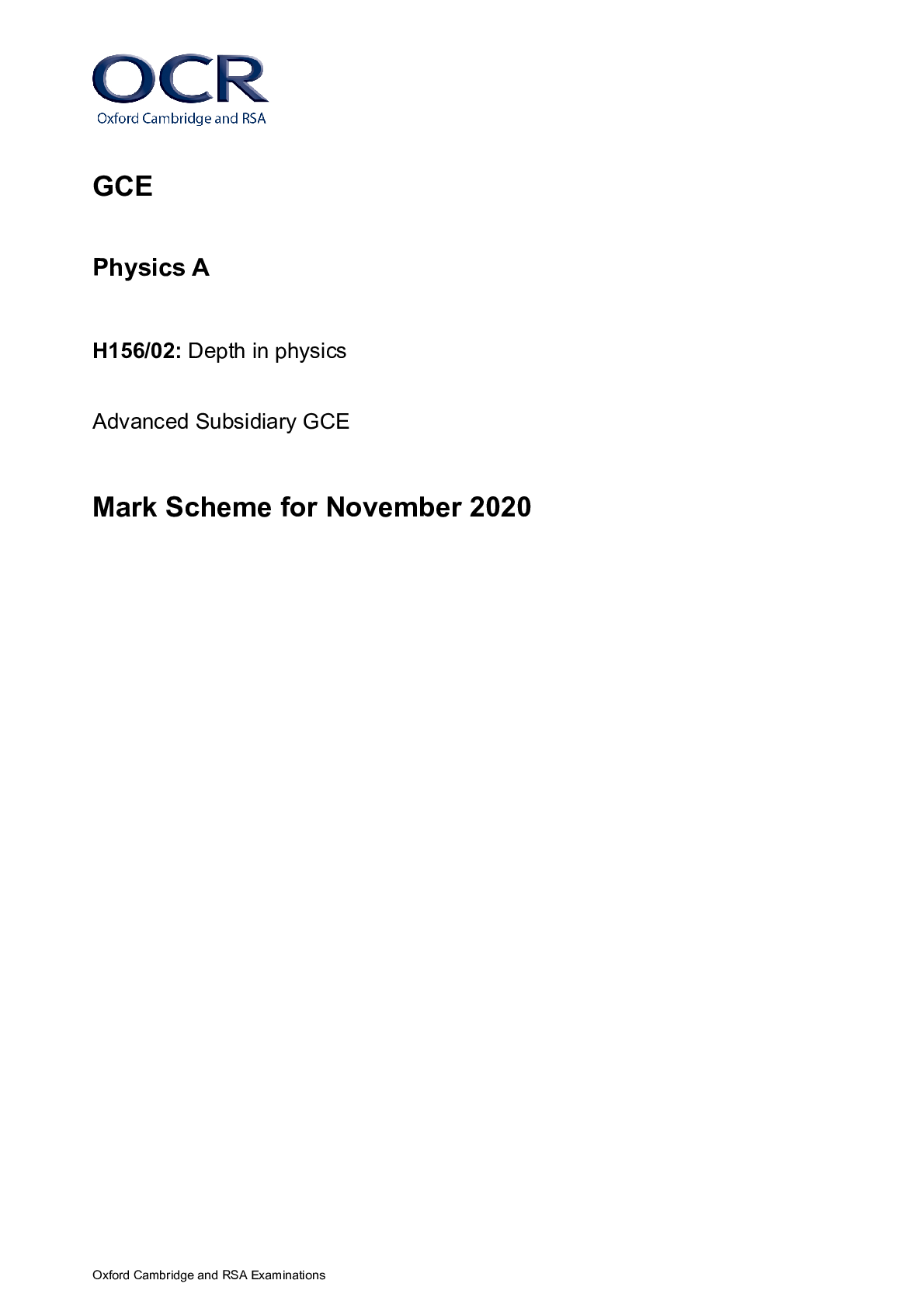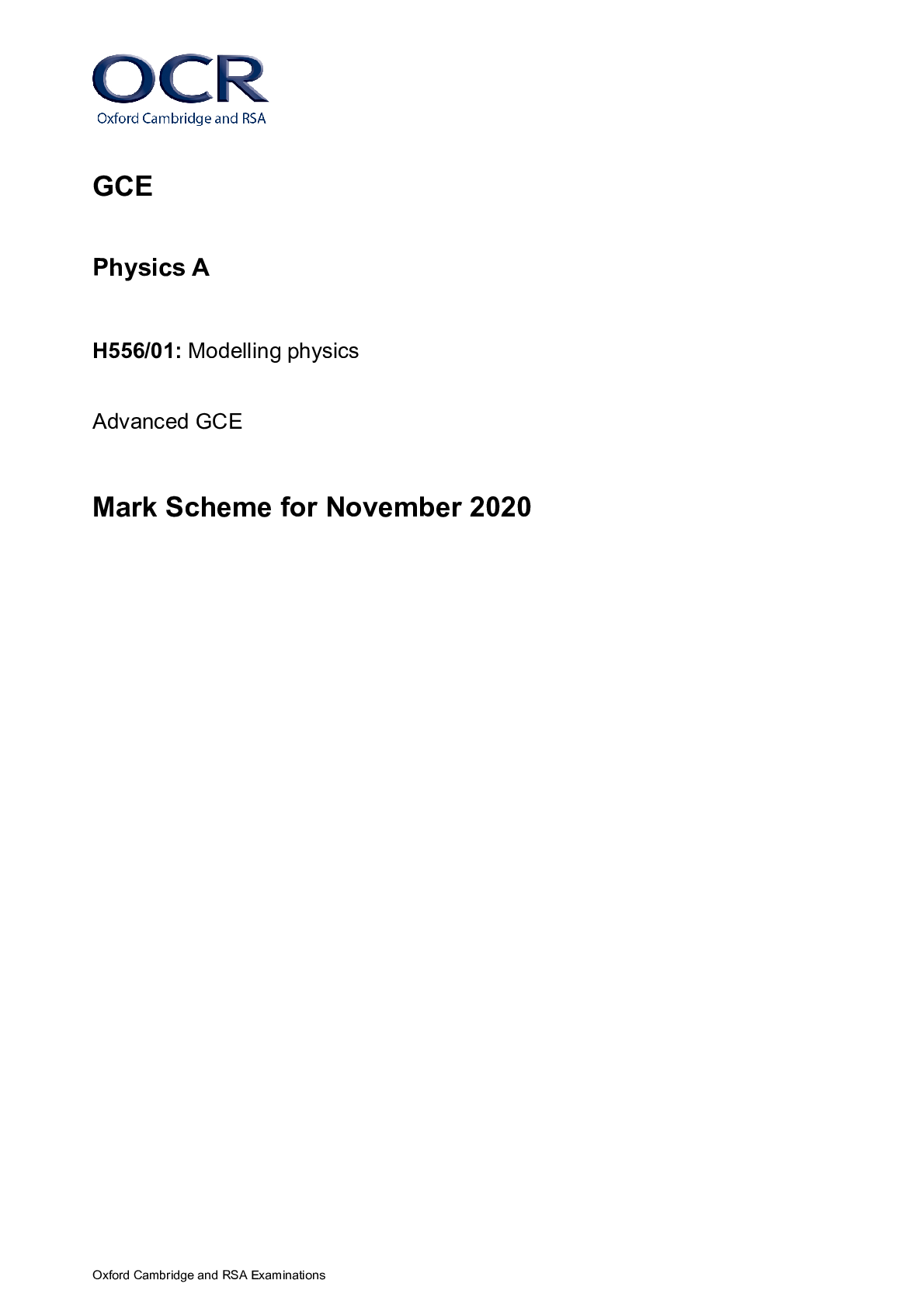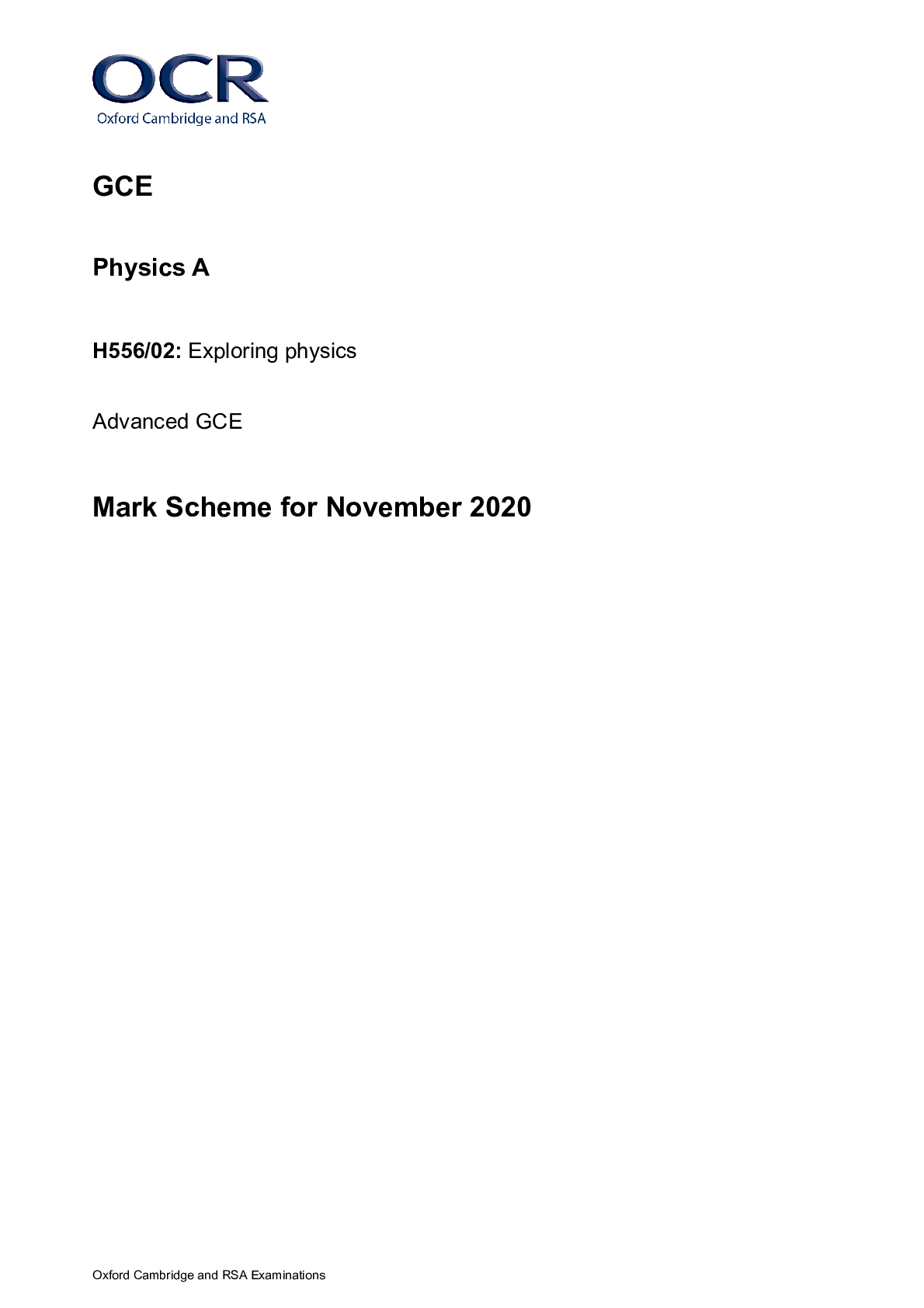Mathematics > AS Mark Scheme > GCE Further Mathematics A Y532/01: Statistics Advanced Subsidiary GCE Mark Scheme for November 2020 (All)
GCE Further Mathematics A Y532/01: Statistics Advanced Subsidiary GCE Mark Scheme for November 2020
Document Content and Description Below
Oxford Cambridge and RSA Examinations GCE Further Mathematics A Y532/01: Statistics Advanced Subsidiary GCE Mark Scheme for November 2020Oxford Cambridge and RSA Examinations OCR (Oxford Cambrid... ge and RSA) is a leading UK awarding body, providing a wide range of qualifications to meet the needs of candidates of all ages and abilities. OCR qualifications include AS/A Levels, Diplomas, GCSEs, Cambridge Nationals, Cambridge Technicals, Functional Skills, Key Skills, Entry Level qualifications, NVQs and vocational qualifications in areas such as IT, business, languages, teaching/training, administration and secretarial skills. It is also responsible for developing new specifications to meet national requirements and the needs of students and teachers. OCR is a not-for-profit organisation; any surplus made is invested back into the establishment to help towards the development of qualifications and support, which keep pace with the changing needs of today’s society. This mark scheme is published as an aid to teachers and students, to indicate the requirements of the examination. It shows the basis on which marks were awarded by examiners. It does not indicate the details of the discussions which took place at an examiners’ meeting before marking commenced. All examiners are instructed that alternative correct answers and unexpected approaches in candidates’ scripts must be given marks that fairly reflect the relevant knowledge and skills demonstrated. Mark schemes should be read in conjunction with the published question papers and the report on the examination. © OCR 2020Y532/01 Mark Scheme November 2020 2 Text Instructions 1. Annotations and abbreviations Annotation in RM assessor Meaning and BOD Benefit of doubt FT Follow through ISW Ignore subsequent working M0, M1 Method mark awarded 0, 1 A0, A1 Accuracy mark awarded 0, 1 B0, B1 Independent mark awarded 0, 1 SC Special case ^ Omission sign MR Misread BP Blank Page Seen Highlighting Other abbreviations in mark scheme Meaning dep* Mark dependent on a previous mark, indicated by *. The * may be omitted if only one previous M mark cao Correct answer only oe Or equivalent rot Rounded or truncated soi Seen or implied www Without wrong working AG Answer given awrt Anything which rounds to BC By Calculator DR This question included the instruction: In this question you must show detailed reasoning.Y532/01 Mark Scheme November 2020 3 2. Subject-specific Marking Instructions for A Level Mathematics A a Annotations must be used during your marking. For a response awarded zero (or full) marks a single appropriate annotation (cross, tick, M0 or ^) is sufficient, but not required. For responses that are not awarded either 0 or full marks, you must make it clear how you have arrived at the mark you have awarded and all responses must have enough annotation for a reviewer to decide if the mark awarded is correct without having to mark it independently. It is vital that you annotate standardisation scripts fully to show how the marks have been awarded. Award NR (No Response) - if there is nothing written at all in the answer space and no attempt elsewhere in the script - OR if there is a comment which does not in any way relate to the question (e.g. ‘can’t do’, ‘don’t know’) - OR if there is a mark (e.g. a dash, a question mark, a picture) which isn’t an attempt at the question. Note: Award 0 marks only for an attempt that earns no credit (including copying out the question). If a candidate uses the answer space for one question to answer another, for example using the space for 8(b) to answer 8(a), then give benefit of doubt unless it is ambiguous for which part it is intended. b An element of professional judgement is required in the marking of any written paper. Remember that the mark scheme is designed to assist in marking incorrect solutions. Correct solutions leading to correct answers are awarded full marks but work must not always be judged on the answer alone, and answers that are given in the question, especially, must be validly obtained; key steps in the working must always be looked at and anything unfamiliar must be investigated thoroughly. Correct but unfamiliar or unexpected methods are often signalled by a correct result following an apparently incorrect method. Such work must be carefully assessed. When a candidate adopts a method which does not correspond to the mark scheme, escalate the question to your Team Leader who will decide on a course of action with the Principal Examiner. If you are in any doubt whatsoever you should contact your Team Leader.Y532/01 Mark Scheme November 2020 4 c The following types of marks are available. M A suitable method has been selected and applied in a manner which shows that the method is essentially understood. Method marks are not usually lost for numerical errors, algebraic slips or errors in units. However, it is not usually sufficient for a candidate just to indicate an intention of using some method or just to quote a formula; the formula or idea must be applied to the specific problem in hand, e.g. by substituting the relevant quantities into the formula. In some cases the nature of the errors allowed for the award of an M mark may be specified. A method mark may usually be implied by a correct answer unless the question includes the DR statement, the command words “Determine” or “Show that”, or some other indication that the method must be given explicitly. A Accuracy mark, awarded for a correct answer or intermediate step correctly obtained. Accuracy marks cannot be given unless the associated Method mark is earned (or implied). Therefore M0 A1 cannot ever be awarded. B Mark for a correct result or statement independent of Method marks. Unless otherwise indicated, marks once gained cannot subsequently be lost, e.g. wrong working following a correct form of answer is ignored. Sometimes this is reinforced in the mark scheme by the abbreviation isw. However, this would not apply to a case where a candidate passes through the correct answer as part of a wrong argument. d When a part of a question has two or more ‘method’ steps, the M marks are in principle independent unless the scheme specifically says otherwise; and similarly where there are several B marks allocated. (The notation ‘dep*’ is used to indicate that a particular mark is dependent on an earlier, asterisked, mark in the scheme.) Of course, in practice it may happen that when a candidate has once gone wrong in a part of a question, the work from there on is worthless so that no more marks can sensibly be given. On the other hand, when two or more steps are successfully run together by the candidate, the earlier marks are implied and full credit must be given. e The abbreviation FT implies that the A or B mark indicated is allowed for work correctly following on from previously incorrect results. Otherwise, A and B marks are given for correct work only – differences in notation are of course permitted. A (accuracy) marks are not given for answers obtained from incorrect working. When A or B marks are awarded for work at an intermediate stage of a solution, there may be various alternatives that are equally acceptable. In such cases, what is acceptable will be detailed in the mark scheme. If this is not the case please, escalate the question to your Team Leader who will decide on a course of action with the Principal Examiner. Sometimes the answer to one part of a question is used in a later part of the same question. In this case, A marks will often be ‘follow through’. In such cases you must ensure that you refer back to the answer of the previous part question even if this is not shown within the image zone. You may find it easier to mark follow through questions candidate-by-candidate rather than question-by-question. f We are usually quite flexible about the accuracy to which the final answer is expressed; over-specification is usually only penalised where the scheme explicitly says so. • When a value is given in the paper only accept an answer correct to at least as many significant figures as the given value.Y532/01 Mark Scheme November 2020 5 • When a value is not given in the paper accept any answer that agrees with the correct value to 3 s.f. unless a different level of accuracy has been asked for in the question, or the mark scheme specifies an acceptable range. NB for Specification B (MEI) the rubric is not specific about the level of accuracy required, so this statement reads “2 s.f”. Follow through should be used so that only one mark in any question is lost for each distinct accuracy error. Candidates using a value of 9.80, 9.81 or 10 for g should usually be penalised for any final accuracy marks which do not agree to the value found with 9.8 which is given in the rubric. g Rules for replaced work and multiple attempts: • If one attempt is clearly indicated as the one to mark, or only one is left uncrossed out, then mark that attempt and ignore the others. • If more than one attempt is left not crossed out, then mark the last attempt unless it only repeats part of the first attempt or is substantially less complete. • if a candidate crosses out all of their attempts, the assessor should attempt to mark the crossed out answer(s) as above and award marks appropriately. h For a genuine misreading (of numbers or symbols) which is such that the object and the difficulty of the question remain unaltered, mark according to the scheme but following through from the candidate’s data. A penalty is then applied; 1 mark is generally appropriate, though this may differ for some units. This is achieved by withholding one A or B mark in the question. Marks designated as cao may be awarded as long as there are no other errors. If a candidate corrects the misread in a later part, do not continue to follow through. Note that a miscopy of the candidate’s own working is not a misread but an accuracy error. i If a calculator is used, some answers may be obtained with little or no working visible. Allow full marks for correct answers, provided that there is nothing in the wording of the question specifying that analytical methods are required such as the bold “In this question you must show detailed reasoning”, or the command words “Show” or “Determine”. Where an answer is wrong but there is some evidence of method, allow appropriate method marks. Wrong answers with no supporting method score zero. If in doubt, consult your Team Leader. j If in any case the scheme operates with considerable unfairness consult your Team Leader.Y532/01 Mark Scheme November 2020 6 Question Solution Marks AOs Guidance 1 (a) –0.954 BC B2 [2] 1.1 1.1 SC: If B0, give B1 if two of 7.04, 29.0[4], –13.6[4] (or 35.2, 145[.2], –68.2) seen (b) Points lie close to a straight line Line has negative gradient B1 B1 [2] 2.2b 1.1 Must refer to line, not just “negative correlation” (c) No, it will be the same as x → a is a linear transformation B1 [1] 2.2a OE. Either “same” with correct reason, or “disagree” with correct reason. Allow any clear valid technical term 2 (a) 1 5 0.2 = M1 A1 [2] 3.3 1.1 Geometric distribution soi 5 (or 5.00…) only (b) 0.82 – 0.810 = 0.533 (0.5326258…) M1 A1 [2] 1.1 3.4 Allow for powers 2, 3, 4 and 9, 10, 11. Awrt 0.533, www. [5201424/9765625] 0.506, 0.378, 0.275, 0.405, 0.302, 0.554, 0.426, 0.324 Or 0.2(0.82 + …. + 0.89), ± 1 term at either end (c) P(≥ 10) = 0.89 = 0.1342… B(30, 0.1342…) Variance = npq = 3.486… M1 A1 M1 A1ft [4] 3.1b 1.1 3.1b 1.1 Or 0.810. Can be implied by correct p [0.10737… is M1A0 here] Stated or implied, their 0.89 or 0.810 In range [3.48, 3.49] 2.875 from 0.810: M1A0M1A1ft SC: 0.134(2) oe not properly shown: B2 for correct final answer.Y532/01 Mark Scheme November 2020 7 Question Solution Marks AOs Guidance 3 (a) Neither B1 [1] 1.2 (b) q = 1.13 + 0.620p B1B1 B1 [3] 1.1,1.1 1.1 0.62(0) correct; both numbers correct Fully correct answer including letters (c) (i) 2.68 B1ft [1] 1.1 awrt 2.68, ft on their (b) if letters correct (c) (ii) 2.5 is within data range, and points (here) are close to line/well correlated B1 B1 [2] 2.2b 2.2b At least one reason, allow “no because points not close to line” Full argument, two reasons needed (d) Not much data here/points scattered/ possible outliers So not very reliable M1 A1 [2] 2.3 1.1 Reason for not very reliable (not “extrapolation”) Full argument and conclusion, not too assertive (not wholly unreliable!) 4 (a) Test is for rankings/rankings arbitrary/not bivariate normal etc B1 [1] 2.4 OE (b) H0: ρs = 0, H1: ρs > 0, where ρs is the population rank correlation coefficient B1 1.1 Allow ρs not defined; allow ρ. Allow: H0: no association between rankings. Ranks 5 4 3 6 1 2 5 1 2 6 4 3 Σd 2 = 20 B1 1.1 H1: positive association (but not H1: association) 6 20 1 s 6 35 r × = − × M1 1.1 = 3/7 or 0.42857… A1 1.1 Exact or awrt 0.429 < 0.9429 B1 1.1 Do not reject H0 M1ft 1.1 FT on their Σd 2 only Insufficient evidence of association between ranking given by the two categories A1ft [7] 2.2b (c) Not dependent on any distributional assumptions B1 [1] 1.2 Oe (cf. Specification, 5.08f)Y532/01 Mark Scheme November 2020 8 Question Solution Marks AOs Guidance 5 (a) Expected frequency for Middle/25 to 60 is 4.4 which is < 5 so must combine cells B1*ft depB1 [2] 2.4 3.5b Correctly obtain this FE, ft on addition errors “< 5” explicit and correct deduction (b) Early Middle Late 29.4 23.1 31.5 26.6 20.9 28.5 B1 1.1 Both, allow 28.4 for 28.5 awrt 2.29, but allow 2.3 In range [2.53, 2.54] Early Middle Late 0.9918 0.4160 2.2937 1.0962 0.4598 2.5351 B1 B1 [3] 1.1 1.1 (c) H0: no association between session and age group. H1: some association ΣX 2 = 7.793 ν = 2, χ2(2)crit = 5.991 Reject H0. Significant evidence of association between session attended and age group. B1 B1 B1 M1ft A1ft [5] 1.1 1.1 1.1 1.1 2.2b Both. Allow “independent” etc Correct value of X 2, awrt 7.79 (allow even if wrong in (b)) Correct CV and comparison Correct first conclusion, FT on their TS only Contextualised, not too assertive (d) The two biggest contributions to χ2 are both for the late session … … when the proportion of younger people is higher, and of older people is lower, than the null hypothesis would suggest. M1ft A1ft [2] 1.1 2.4 Refer to biggest contribution(s), FT on their answers to (b), needs “reject H0” Full answer, referring to at least one cell (ignore comments on next highest cells)Y532/01 Mark Scheme November 2020 9 Question Solution Marks AOs Guidance 6 (a) Failures occur to no fixed pattern/are not predictable B1 [1] 1.1 OE. NOT “independent” (b) Failures occur independently of one another and at constant average rate B1 B1 [2] 1.1 1.1 Not recoverable from (a) if independence not restated here; must be contextualised Ignore “singly”. Allow “uniform” rate, not “constant rate” or “constant probability”; must be contextualised (c) Variance (1.6384) ≈ mean So suggests that it is likely to be well modelled M1 A1 [2] 1.1 3.5a Compare variance (or SD). Allow square/square-root confusion Correct comparison and conclusion, 1.64 or better seen (d) e−1.61 B1 [1] 3.4 Exact needed, allow even if 0! or 1.610 or both left in (e) 1 ≥ 2 0.322 0.478 B1 B1 [2] 3.4 1.1 One correct e.g. 0.3218 Other correct e.g. 0.4783 (f) P(F = 1) will be smaller as single failures are less likely B1* depB1 [2] 3.5c 3.3 OE. Partial answer: B1Y532/01 Mark Scheme November 2020 10 Question Solution Marks AOs Guidance 7 2 2 3 3 2 (2 1) 3 (3 1)(3 2) 2 6 m m C m C m m m m m m × − − − = × ÷ M1 M1 3.1b 3.1b Use 2mC2 and m Divide by 3mC3 = 2 (2 1) (3 1)(3 2) m m m m − − − A1 2.1 Correct expression in terms of m (allow with m not cancelled yet) 28 55 2 (2 1) (3 1)(3 2) m m m m − = − − M1 3.1a Equate to 55 28 & simplify to three-term quadratic ⇒ 16m2 – 71m + 28 = 0 A1 2.1 Correct simplified quadratic, or (quadratic) × m, = 0, aef m = 4 BC M1 1.1 Solve to get both 4 and 16 7 Reject m = 16 7 as m is an integer A1 [7] 3.2a Explicitly reject m = 16 7 OR: 2 (2 1) 3! 3 (3 1)(3 2) 2 m m m m m m − × × − − × then as above Multiplication method can get full marks, but if no 3 or 3!, max M1M0A0 M1A0M0A0OCR (Oxford Cambridge and RSA Examinations) The Triangle Building Shaftesbury Road Cambridge CB2 8EA OCR Customer Contact Centre [Show More]
Last updated: 1 year ago
Preview 1 out of 12 pages

Buy this document to get the full access instantly
Instant Download Access after purchase
Add to cartInstant download
We Accept:

Reviews( 0 )
$6.50
Document information
Connected school, study & course
About the document
Uploaded On
Oct 10, 2022
Number of pages
12
Written in
Additional information
This document has been written for:
Uploaded
Oct 10, 2022
Downloads
0
Views
38

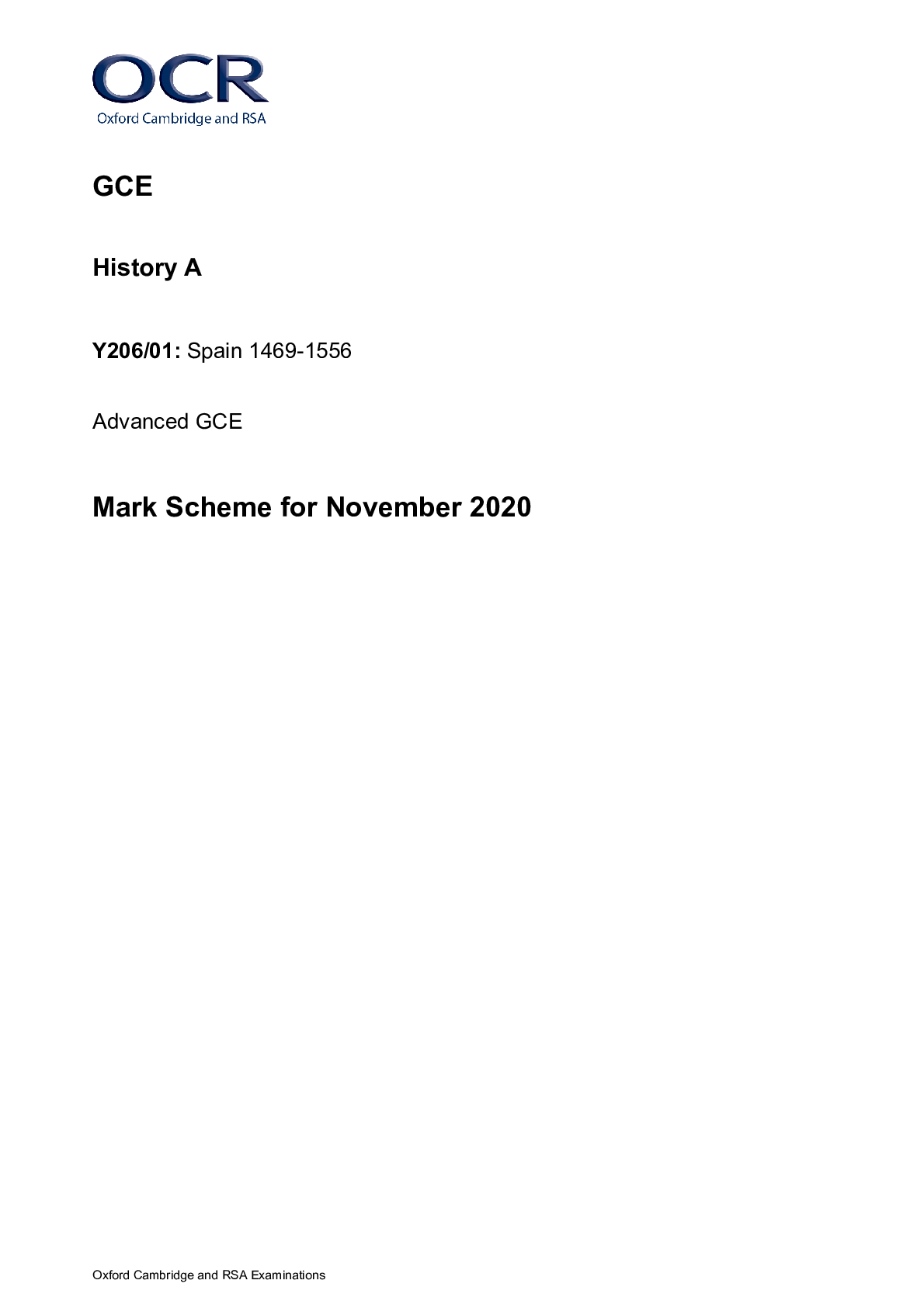
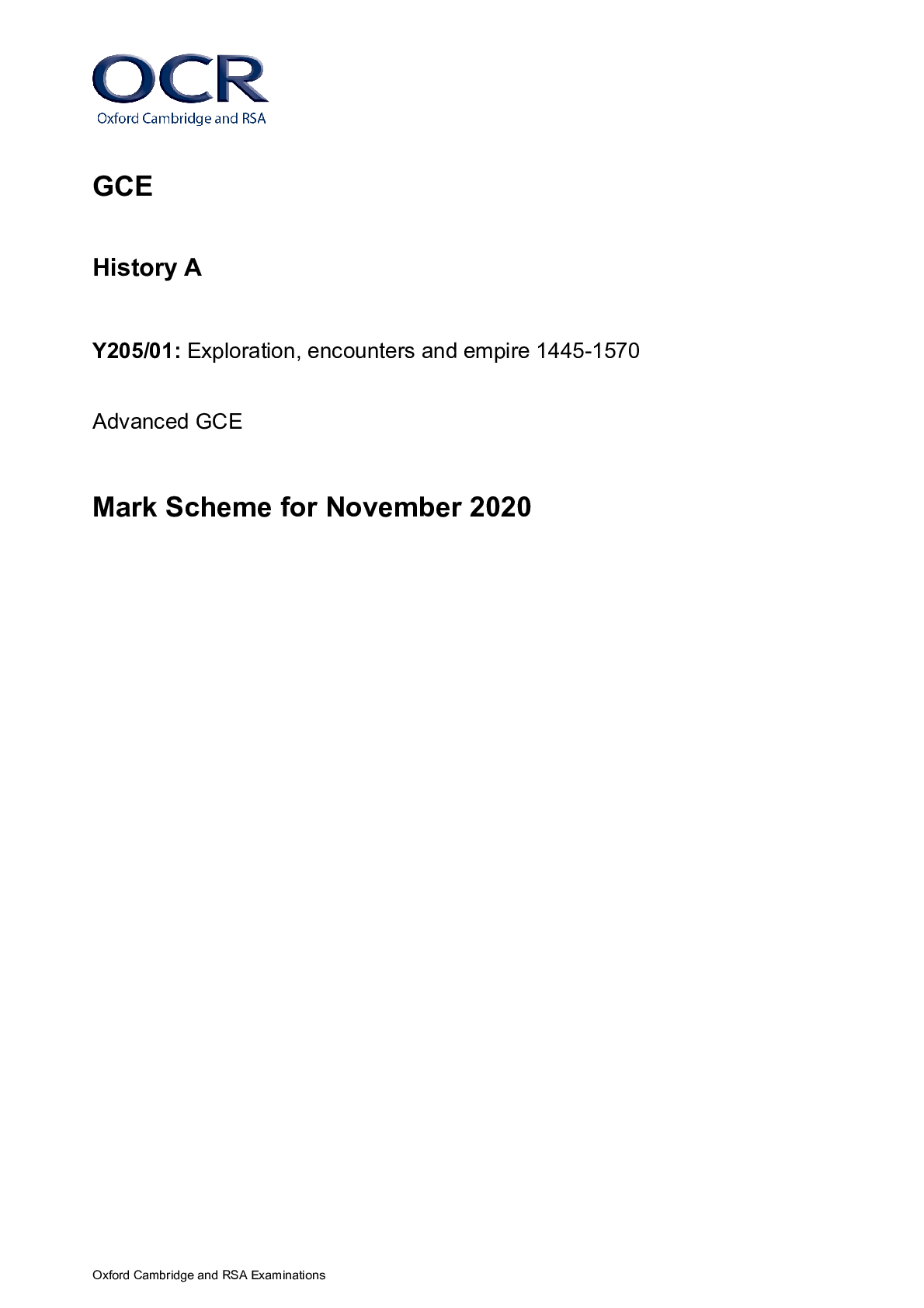






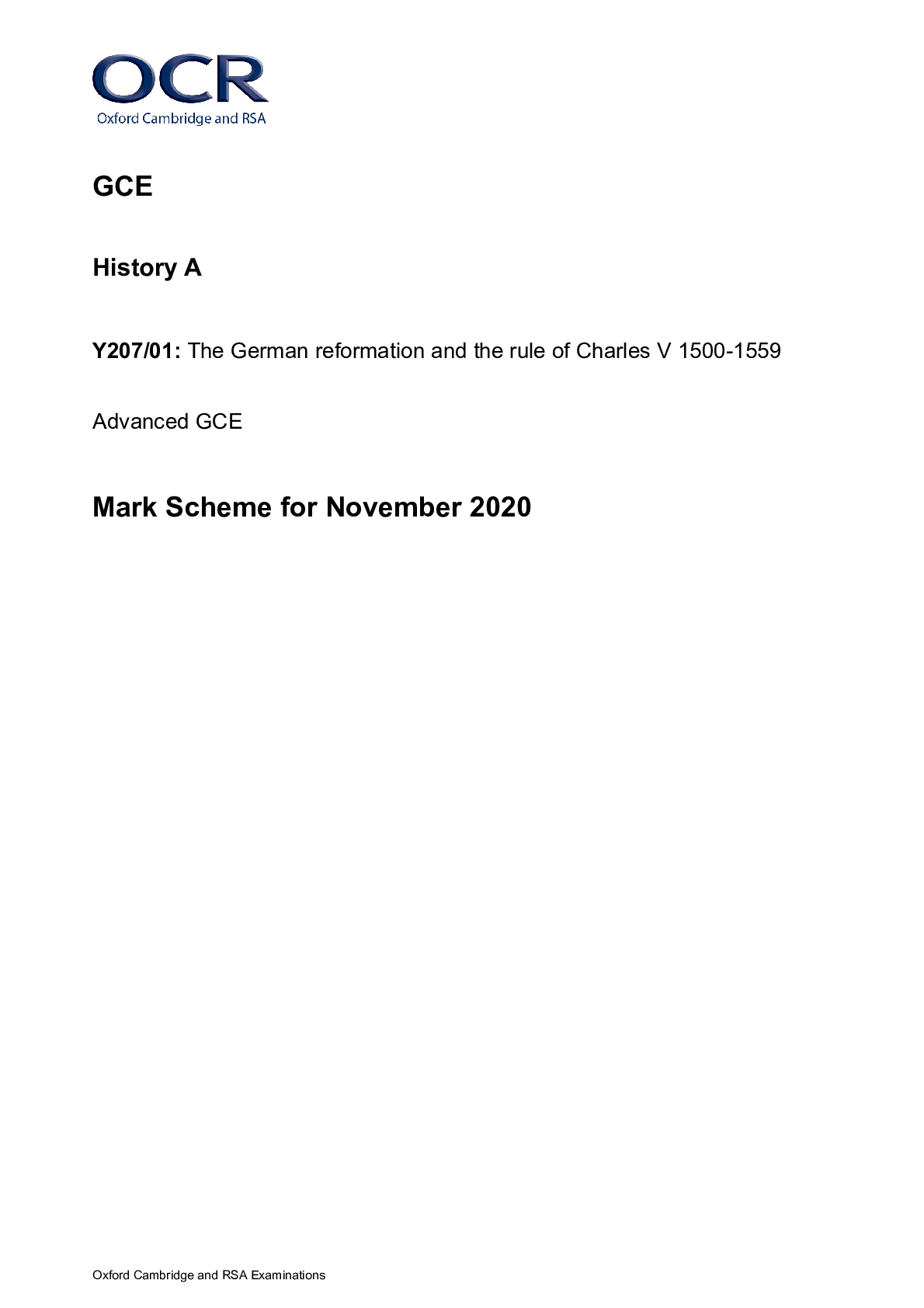






.png)



